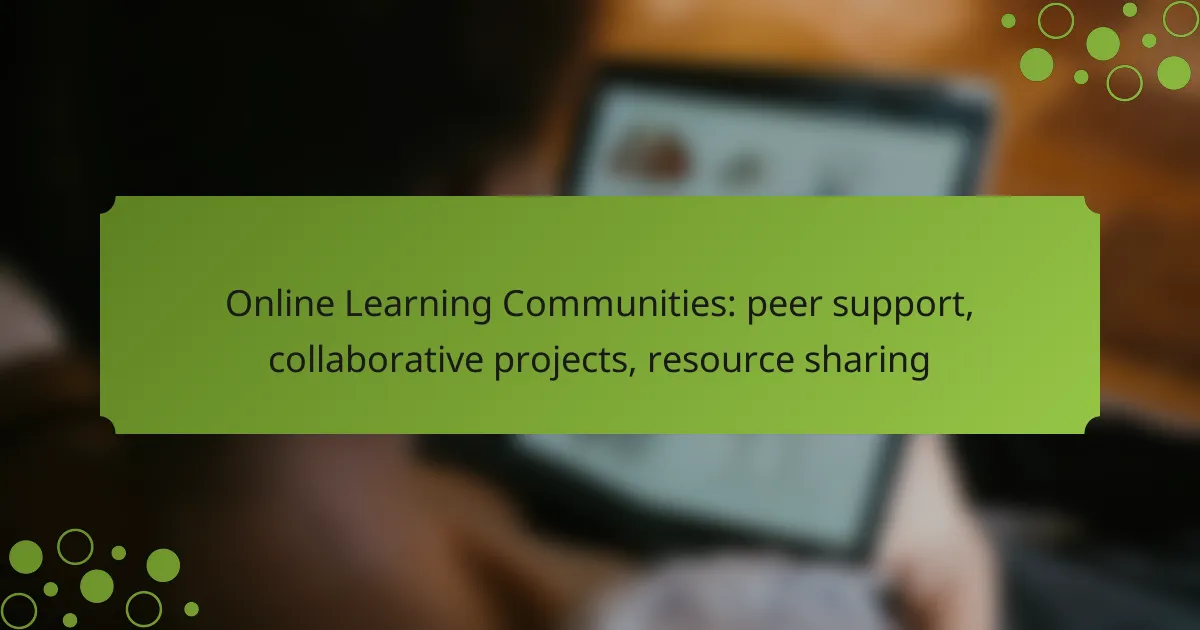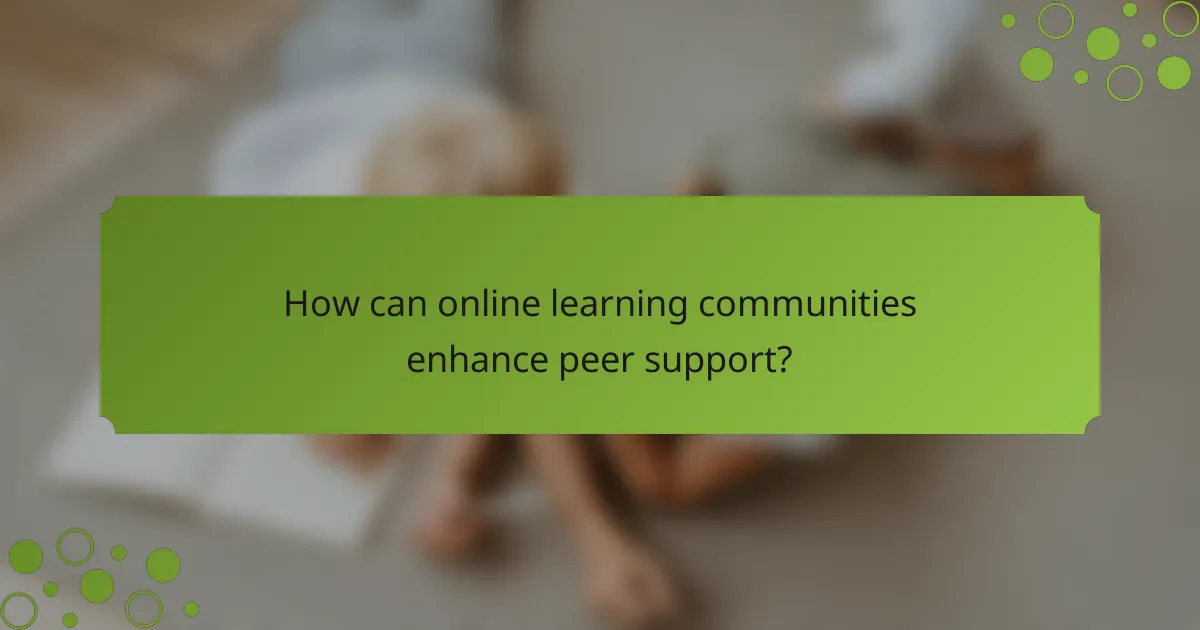
Online learning communities play a crucial role in enhancing the educational experience by promoting peer support and collaboration among learners. These platforms facilitate connections that allow individuals to share resources, engage in collaborative projects, and motivate one another, ultimately leading to a more enriching and effective learning journey.

How can online learning communities enhance peer support?
Online learning communities significantly enhance peer support by fostering connections among learners who share similar goals and challenges. These platforms create an environment where individuals can collaborate, share resources, and motivate each other, leading to a more enriching educational experience.
Increased motivation through accountability
Accountability is a powerful motivator in online learning communities. When learners commit to group projects or study sessions, they are more likely to stay on track and complete their tasks. This can be achieved through regular check-ins or progress updates, which encourage members to uphold their commitments.
For example, forming study groups where members set deadlines for assignments can create a sense of responsibility. Tools like shared calendars or project management apps can help keep everyone accountable and engaged.
Emotional support from shared experiences
Emotional support is a crucial aspect of peer interactions in online learning communities. Sharing experiences, such as challenges faced during coursework or feelings of frustration, allows members to empathize with one another. This shared understanding can create a supportive atmosphere that helps reduce feelings of isolation.
Participating in discussion forums or virtual meetups can provide a safe space for learners to express their concerns and receive encouragement. Simple gestures, like offering words of encouragement or sharing personal stories, can significantly uplift community morale.
Access to diverse perspectives
Online learning communities offer access to a wide range of perspectives that enrich the learning experience. Members from different backgrounds and cultures can contribute unique insights, enhancing discussions and collaborative projects. This diversity encourages critical thinking and broadens understanding of various subjects.
To leverage these perspectives, community members should actively engage in discussions and seek input from others. Asking open-ended questions can stimulate dialogue and help uncover new ideas, making the learning process more dynamic and comprehensive.

What collaborative projects can be implemented in online courses?
Collaborative projects in online courses enhance learning by fostering teamwork and practical application of knowledge. These projects can take various forms, allowing students to engage actively and share resources effectively.
Group assignments for real-world applications
Group assignments can simulate real-world scenarios, encouraging students to apply theoretical knowledge to practical problems. For instance, a marketing class might require teams to develop a campaign for a local business, integrating research and strategy.
When organizing group assignments, consider the diversity of skills within the team. Assign roles based on individual strengths to maximize productivity and ensure that all members contribute meaningfully. Setting clear deadlines and expectations is crucial for successful collaboration.
Peer-led study sessions
Peer-led study sessions allow students to learn from each other in a structured environment. These sessions can be scheduled regularly, focusing on specific topics or challenging concepts, and can be conducted via video conferencing tools.
To facilitate effective peer-led sessions, establish guidelines for participation and encourage all members to prepare questions in advance. This approach not only reinforces learning but also builds a sense of community among participants.
Joint research initiatives
Joint research initiatives enable students to collaborate on academic inquiries, often resulting in shared findings that contribute to their fields of study. These projects can range from small-scale studies to larger, more comprehensive research efforts.
When planning joint research, select topics that resonate with all participants and align with course objectives. Utilize collaborative tools like shared documents and project management software to track progress and maintain organization throughout the research process.

How can resource sharing benefit online learners?
Resource sharing enhances online learning by providing access to diverse materials and tools, fostering collaboration among peers. This collaborative environment not only enriches the learning experience but also helps learners overcome challenges through shared knowledge and resources.
Access to curated learning materials
Curated learning materials are collections of high-quality resources that have been selected based on relevance and effectiveness. Online learners can benefit from these resources, which may include articles, videos, and interactive modules, tailored to specific subjects or skills.
For example, a community focused on coding might share links to the best online tutorials, coding challenges, and documentation. This saves time and ensures learners are accessing the most valuable content available.
Shared tools and platforms for collaboration
Online learning communities often provide access to various collaborative tools and platforms that facilitate group work. These can include shared document editors, project management software, and communication apps that allow learners to work together seamlessly.
Utilizing tools like Google Docs or Trello can help learners organize projects and maintain clear communication, which is crucial for successful collaboration. It’s essential to choose platforms that are user-friendly and widely adopted within the community.
Community-driven knowledge bases
A community-driven knowledge base is a collective repository of information created and maintained by its members. This can include FAQs, tutorials, and best practices that are continuously updated to reflect the latest insights and solutions.
For instance, a forum dedicated to language learning might have a section where members contribute tips on grammar, vocabulary, and pronunciation. This collaborative effort not only builds a rich resource but also fosters a sense of belonging and support among learners.

What are the prerequisites for joining an online learning community?
Joining an online learning community typically requires basic digital literacy and a readiness to engage with others. These prerequisites ensure that members can effectively participate in discussions, collaborate on projects, and share resources.
Basic digital literacy skills
Basic digital literacy skills include the ability to navigate online platforms, use communication tools, and access shared resources. Familiarity with common software applications, such as word processors and spreadsheets, is also beneficial.
Consider taking a short online course if you feel unsure about your digital skills. Many platforms offer free resources to help you improve your proficiency in essential tools and technologies.
Willingness to engage and collaborate
A willingness to engage and collaborate is crucial for thriving in an online learning community. This means being open to sharing your ideas, providing feedback, and participating in group projects.
To foster collaboration, actively contribute to discussions and be respectful of diverse opinions. Remember that successful teamwork often relies on clear communication and mutual support among members.

How do online learning communities compare to traditional classrooms?
Online learning communities offer a more flexible and collaborative approach compared to traditional classrooms. They emphasize peer support, resource sharing, and collaborative projects, allowing learners to engage at their own pace and connect with a diverse group of participants.
Flexibility in learning schedules
Online learning communities provide significant flexibility in terms of scheduling. Participants can access materials and engage in discussions at their convenience, which accommodates various time zones and personal commitments. This flexibility is particularly beneficial for working professionals or students with other responsibilities.
For example, learners can choose to participate in discussions or complete assignments during evenings or weekends, rather than adhering to a fixed timetable. This self-directed approach can lead to enhanced motivation and better retention of information.
Diverse global participation
Online learning communities attract participants from around the world, fostering a rich exchange of ideas and perspectives. This diversity enhances the learning experience, as individuals bring unique cultural backgrounds and insights to discussions and projects.
Engaging with peers from different countries can also help learners develop a global mindset, which is increasingly valuable in today’s interconnected world. For instance, a project team might include members from Europe, Asia, and North America, allowing for a broader range of solutions and approaches to problem-solving.

What platforms support online learning communities?
Several platforms effectively support online learning communities by facilitating peer support, collaborative projects, and resource sharing. These tools enhance communication and organization, making it easier for learners to engage and collaborate.
Slack for real-time communication
Slack is a popular platform for real-time communication in online learning communities. It allows users to create channels for specific topics, making it easy to organize discussions and share resources efficiently.
Consider using Slack’s integration features, such as file sharing and app connections, to streamline collaboration. For example, you can connect Google Drive to share documents directly within channels, enhancing accessibility and teamwork.
Discord for interactive discussions
Discord is designed for interactive discussions, making it ideal for online learning communities that thrive on engagement. With voice channels, video calls, and text chat, it fosters a dynamic environment for collaboration and peer support.
Utilize Discord’s server roles to manage permissions and create a structured community. Setting up dedicated channels for different subjects or projects can help keep conversations organized and focused.
Moodle for course management
Moodle is a comprehensive learning management system that supports online learning communities through course management features. It allows educators to create structured courses, share resources, and facilitate discussions among students.
When using Moodle, take advantage of its assessment tools and forums to encourage collaboration. For instance, you can create group assignments that require peer feedback, promoting interaction and resource sharing among learners.

What emerging trends are shaping online learning communities?
Online learning communities are increasingly influenced by trends such as peer support, collaborative projects, and resource sharing. These elements foster engagement and enhance the learning experience by leveraging the collective knowledge and skills of participants.
Peer support in online learning
Peer support is a critical component of online learning communities, providing students with emotional and academic assistance. This support can take various forms, including discussion forums, study groups, and mentorship programs, allowing learners to connect and share experiences.
To effectively implement peer support, consider establishing clear guidelines for interaction and encouraging participation through incentives. For instance, offering recognition or rewards for active contributors can motivate members to engage more fully.
Collaborative projects
Collaborative projects enhance the learning experience by allowing participants to work together towards common goals. These projects can range from group assignments to community-based initiatives, promoting teamwork and practical application of knowledge.
When organizing collaborative projects, ensure that roles and responsibilities are clearly defined to avoid confusion. Tools like shared documents and project management software can facilitate coordination and communication among team members.
Resource sharing
Resource sharing is essential in online learning communities, enabling members to access a wealth of information and tools. This can include sharing articles, videos, and study materials, which enrich the learning environment and support diverse learning styles.
To encourage resource sharing, create a centralized repository where members can easily upload and access materials. Regularly highlight valuable contributions to motivate ongoing participation and ensure that resources remain relevant and up-to-date.


